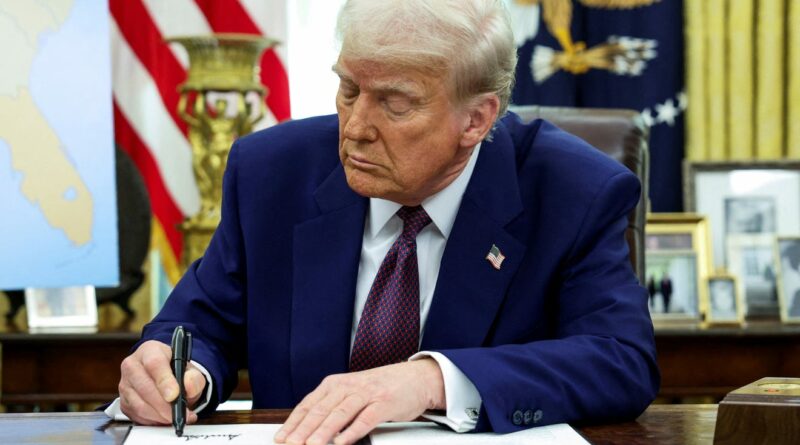Tariffs Friend or Fiend? Part 2
Source : patreon.com – April 8, 2025 – Stanislav Krapivnik
https://www.patreon.com/posts/tariffs-friend-2-126208072
Abonnez-vous au canal Telegram Strategika pour ne rien rater de notre actualité
Pour nous soutenir commandez les livres Strategika : “Globalisme et dépopulation” , « La guerre des USA contre l’Europe » et « Société ouverte contre Eurasie »
Now, dear reader, for the issue of the tariffs or why you most likely started reading my long-winded dissertation in part 1.
We wrote that tariffs should not be considered the bane of all ‘protectionist’ evil, they are a tool. And if used properly, they can help the user get stronger. The best case study for Americans of all time is their own history of explosive industrialization (despite multiple Wall Street/City of London engineered financial panics) prior from the Civil War through 1914, well before any World Wars damaged manufacturing in European nations. This gives lie to a common ‘free trader’ argument, that the US only enjoyed postwar prosperity due to much of Europe being in ruins following WW2, and lazy and unionized American autoworkers were vastly outperformed by German and Japanese workers, who made smaller and more fuel efficient vehicles. But it’s true that since the 1970s, the US has struggled with making non-truck/SUV passenger vehicles the rest of the world wants, especially in Europe or East Asia. Hence the dunking on X against Trump White House advisor Stephen Miller’s tweet that he doesn’t see Europeans driving American cars.
How Tariffs Can Be Abused for Special Interests, Leading to Decades of Stagnation
Nonetheless, when tariffs get abused, particularly by narrow special interests, a national policy fails or can even create perverse incentives. For example, to manufacture less and boost stock prices through share buybacks and mass layoffs. We’re no longer in a world, especially after the Obama Administration Cash for Clunkers bailouts of 2009-2010, where it can be honestly said that whatever is good for General Motors is good for America, so tariffs can and will backfire. Over the long term, tariffs can even do more damage to an economy than sanctions, which have failed miserably to stop Russia’s massive wartime reindustrialization. Which the head of EURCOM General Christopher Cavoli recently acknowledged in his testimony to Congress.
A textbook example of tariffs failing to achieve anything but economic sclerosis was the Peronist policies of Argentina, which stagnated what had been among the world’s fastest growing economies in the early 20th century.
The Distinction Between Tariffs and Sanctions
At this point, some may say, what’s the difference between tariffs and sanctions? Especially when Trump and ex-McCain pilot fish Senator Lindsey Graham (RINO-SC) are threatening Russia’s trade partners like India with punitive tariffs on their exports to the US if they don’t stop buying Russian crude oil, to coerce Moscow into a peace deal that leaves the militarized Kiev regime fully intact.
The difference between sanctions and tariffs, however, is actually quite discernable to the naked eye.
If you impose sanctions on the products of said nation and you go to the store to procure those products, you will find the shelves empty and those products from said nation will be missing. If you impose tariffs on those same products and you go to the store, you will find those products on the shelves, though maybe in smaller quantities, since the prices of said products will now go up by the approximate amount of the tariff. The tariff is passed on to the end user. The quantity of the tariff passed on depends on market forces and the seller may swallow a portion from out of his profit to stay competitive, or he may pass it on fully to the end consumer.
The benefit of the tariff for the government is of course profit, since the cost of the tariff goes directly into the coffers of the tariffing government, though this may also be offset somewhat by the decrease in quantity imported and sold. Trump is correct that prior to 1913, when the US imposed the income tax for the first time on just 2% of the US population prior to American entry into WW1, the US government was largely funded by tariffs. Of course, the federal government as well as the US military industrial establishment were relatively tiny then in comparison to their current bloated, globe-spanning empire of bases behemoth status. Either way, tariffs in effect become an indirect tax on the end consumer, since he will shoulder more of the burden than the seller. But contrary to neoliberal economist poo pooing, sellers still are impacted, hence China’s declarations that it’s ready to fight Trump’s tariffs to the end–which sounds to Russian ears like the old Soviet joke from the Maoist era about « China’s final warning ».
It’s nonetheless a fallacy to say that the manufacturer will simply swallow the tariff. This may only be if the manufacturer and importer are one and the same and especially so if the end seller is also the same as the manufacturer and importer. Where the products are purchased and imported from a tariffed country, the manufacturer who sold price X will more than likely still sell goods at price X. He can be asked to swallow a portion of said tariff, as the Vietnamese and Indian textile/shoe manufacturers who were the beneficiaries of moving shoe and apparel production out of China trend during Trump’s first term. But more than likely, they will refuse. You see, with tariffs the tariff is paid for by the importing entity, not the manufacturer. It is this importing entity that must answer to the government and pay the fee, which in most cases will just be passed on as the price to the selling entity, and thus handed to the end consumer.
So now that we understand tariffs, how do we best use them?
Tariffs of course are deployed first and foremost as a defensive tool for the protection of an industry or an economy from cheaper, more efficient foreign competition. Many developing economies or even developed economies have suffered a hard crash from getting flooded by superior quality and cheaper imports, including a post Soviet Russia during the 1990s and early 2000s. But countries like Russia are starting to regain their footing, using tariffs and other forms of protection to help their fledgling industries and companies.
This of course works only if said companies are seeking to fill strong internal demand and if the implementing country does not export anything to the tariffed country, as more than likely, the tariffed country will counter-tariff those sectors of the initiator’s economy that are exporting to them. Thus the damage caused by the counter tariffs may outweigh the gains from the initial tariff and protecting the selected sector.
Of course, slapping harsh tariffs on another country can also cause diplomatic harm, particularly when the tariffed country also happens to be militarily and diplomatically powerful like China. And many China bulls are arguing that the US badly needs Chinese goods, especially the nearly embargoed rare earths and still relatively cheap but decent quality Chinese products—far more than the Chinese need American soybeans and pork bellies. Of course we mentioned this point and the inevitability of higher inflation due to tariffs on Chinese goods in America, during our recent Eyes of Truth video discussion of tariffs.
A huge part of Russia’s leverage is not only military power and large scale arms production, but the fact that the EU needs its energy, food and metals far more than Russia needs the EU’s cars or trinkets, which in any case can be reimported via the likes of Armenia, Turkey, the UAE or Kazakhstan. But those advantages of Russian semi-autarchy are not the main points of today’s discussion, especially since China has to import grain and energy to feed its people and livestock. Massive Chinese imports of Russian food and energy is one of the most important reasons why any Trump Administration hopes for a ‘Reverse Nixon’ policy of wooing Russia against China are going to be disappointed. For our Russian purposes, as former President Dmitry Medvedev observed last week, Russia hardly does hardly any direct trade with the US at all, and that only in select metals like titanium for Boeing planes or processed uranium for US reactors. But major Russian trade partners led by China, India, Turkey and Vietnam are being heavily impacted by the Trump tariffs.
In the case of the United States, the reasons that so many companies fled the US from President Nixon’s 1970s formal abandonment of the gold standard onward are multifaceted. It is easy to oversimplify that it was all just greedy mega corps chasing cheap Chinese labor, and this of course played a role of its own. But today Chinese labor is no longer so cheap, as the PRC has moved its work force up the value added chain. In truth, there are many issues with manufacturing in the U.S. For example, worker’s compensation insurance for on-the-job incidents. This is based on the job done as a percentage of the employee’s salary. So an office worker normally costs around the 5% mark, while a factory worker runs up to 70%-80% of their salary. In effect, you get one worker for the price of two and do not forget all the other employee taxes the employer faces.
Then there are the insane HSE (Health Safety and Environment) regulations, both Federal and State. The high taxes, though Trump did lower the US from highest corporate tax rates to middling by world standards. There’s also the lawsuit happy culture, especially for slip and fall or trucking accidents, plus the decaying U.S. infrastructure. California, the most populous state in the US and once a defense and civilian manufacturing powerhouse, has regular rolling brownouts, since it lacks the electrical capacity to keep everyone and everything running.
There are crumbling American bridges and potholed roadways, water line breaks from coast to coast. Not to mention dockyard worker and various other strikes by unions. Which brings us to the subject of the workers themselves. Forty years of dumbing down the US education system has done its job. Skilled workers are in short supply, though woke liberal arts majors are a dime a dozen and the work ethic of the youngest generation leaves plenty to be desired.
So the proper approach to this catastrophe could be to first fix the problems that caused all those companies to flee offshore, to create an extremely business friendly environment and then and only when that’s accomplished, to place big tariffs on the various sectors, determined sector by sector but likely starting with autos and tractors, to help drive business home.
Of course, the Trump Administration in our opinion has done all of this backwards. The various reasons why business or rather manufacturing fled the US are all alive and well but now we have the tariff regime on top of all that which brings on a counter tariff regime. These will hit the largest US export sectors such as agriculture and energy (oil, LNG and coal).
It would be easy enough to toss this up to something like Trump’s ignorance and in part, that may be so, but the reality is, Trump has been amazingly consistent in his critique of ‘free trade’ for over 40 years. This is the protracted illness of the entire U.S. regulatory system and body politic. Long-term planning is out of the question as is the extended years of investment that goes with it. There are mid-term elections and if the Republicans lose and that is the tendency in the US that the sitting president’s party loses often bigly in those elections, Trump’s quest for high tariff policies gets overturned. Hence this White House is in a hurry, but curing America’s major ills will take years, as these problems grew up in decades. Additionally, many of these problems are on the level of the individual states and the power of the federal government to influence things like California regulations or New York labor laws is limited.
Then of course is the issue that the knowledge of the social sciences, that is economics, in the US is extremely low. This is reflected as well in Trump’s team and even amongst the theoretical bound midwit intelligentsia, who buy into manifestly idiotic, but satisfyingly smug slogans like ‘Russia is just a gas station with nuclear weapons’ or ‘Russia has an economy smaller than Italy’s’. It is quite a thin talent pool and tends to be, as was stated earlier, absolutely black and white politically correct—that is credentialed but not educated on most issues, instead of recognizing the less dogmatic nuances that most of the world works in. Admittedly the ideological slipperiness of many foreign governments can often lead to absurdities: for example, in Argentina where yesterday’s IMF bashing libertarian Javier Milei becomes today’s $20 billion plus IMF loan salesman to the Argentine public. But the groupthink of most US ‘elite universities’ on economics and foreign policy alike have successfully stymied desperately needed reforms—until now.
But the direct tariffs will also hit America’s home industries as well, as most complex manufacturers use some amount of imported parts and materials and not a small amount of these can not be found in the US. Thus the number of fully Made in the USA goods will eventually increase, but not before there are serious shortages from the supply chain shock.
Now one shock most Americans did not think of: an increase in price even from all-American made goods. Lets discuss in depth. Say if you are in an industry where half the competition imports their wares for sale vs you who loyally makes it all in the USA. And one day all your competitor’s goods go up in price 20%, what do you do? You can of course increase manufacturing capacity to fill in the market share of your importing competitors, but now you have much more expensive competition. This may be done but this will take time to bring to reality. In the short term and going forward, the logical answer would be to raise prices and earn more money. So the competition is now 20% more expensive? Ok, I will raise prices 17%, still stay below the competitors and rake in the profits. Thank you Uncle Sam! This is going to be a big reason even fully Made in USA and pro-MAGA Midwestern industrialists are going to pass on inflation to President Trump’s heartland supporters. Who statistically and anecdotally are more likely to be blue collar laborers who work with tools in hand.
Even if those companies affected by the industry wide price shocks wished to quickly relocate their manufacturing from Canada or Mexico just a few hundred miles away to the US, it will not be that easy. To move a factory to an empty greenfield or a gutted brownfield building takes times. Those old factory buildings are in horrid shape and are mostly empty, without even the basic utility hookups. Preparing a site and moving equipment may take 1-3 years, and if you are a high tech chip manufacturer, removing the dust takes 3-5 years to make a perfect dust-free environment. Serious investment in machinery and highly specialized labor is required.
Then there are the questions of finding employees, which marred the ballyhooed insourcing of an Intel plant from China’s autonomous island of Taiwan to Arizona. Who in the modern very low skilled labor force is going to work inside your new manufacturing hub? Intel found that many managers from Taiwan did not want to move to Arizona, and some of their old hands from the 1980s and 1990s heyday are either retired or moved on from the chips industry. Even if you can find enough managers and workers, the work force will skew much older and will not return without serious payouts. Just getting and preparing a reliable and qualified work force could become a bridge too far, as it has proven for bringing Intel to the US desert Southwest.
Again, the Trump tariff spree does nothing to address these medium to long term issues. Our advice to Americans is to get ready for higher prices, cut backs in exporting US industries and a lower standard of living. And if you happen to be an American or German Christian manufacturing manager who wants to raise children, then consider moving to Russia as a leading manufacturing power.




